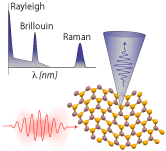2D Materials Chemistry
A 2D layered material consists of a series of tightly bonded layers one to five atoms thick alternating with van der Waals gaps. These gaps can serve as hosts for a variet of intercalant guests. We are developing new synthetic routes to produce 2D materials with novel properties, whether through vapor-phase growth, chemical synthesis, or topotactic reaction. One 2D material that we have developed is silicon telluride (Si2Te3), a p-type semiconductor with strong photoluminescence in the red (641 nm) that can be synthesized as large thin flat plates, standing plates, nanoribbons, and colloidal nanocrystals. A critical goal in materials research is the direct control of structure to achieve novel properties. We have developed an innovative intercalation chemistry to reversibly place high densities of zero-valent metal atoms between successive layers in 2D layered materials, thereby achieving atomic-scale chemical control. Whereas most intercalation chemistries move ions, this method is chemical, moving metal atoms and generating an atomically thin sheet of metal within the host. Because intercalants are zero-valent and require no change in host stoichiometry, multiple metals at high densities can be co-intercalated. For example, we can intercalate up to 60 atomic percent into Bi2Se3 yielding Cu7.5Bi2Se3 while also making it more transparent and more conductive. From a fundamental standpoint, this technique gives rise to exciting anisotropic properties and unusual electronic transport properties arising in part from quantum confinement in one dimension. Layered materials can be tuned electronically, structurally, and optically. This chemistry opens up an unprecedented array of new challenges and new physics in 2D materials.

2D Materials Physics
The materials we develop exhibit a wide range of unique phenomena such as topological insulator behavior, charge density waves, and acoustic plasmons. We are currently developing the techniques and materials to establish the fundamental physics unique to 2D and intercalated layered materials. For example, as 2D materials become integrated into new technologies and material dimensions are reduced below an acoustic mean free path length, quantized phonon effects impact heat transport, interfere with electronic transport, and alter material mechanical properties. Therefore, we are using Brillouin laser light scattering, a non-invasive laser light scattering technique to measure the acoustic phonon dispersion properties of 2D materials. We also couple in-situ TEM techniques with these investigations to understand charge density waves and acoustic plasmons in 2D layered materials.

2D Materials Application
Our synthetic material chemistries open new ground for accessing novel opto-electronic properties. We are developing chemically tunable opto-electronics and Smart Material devices.

Layered Biological Materials
Biology has evolved throughout millions of years to achieve the ultimate optimization of structure-properties-and-performance. Because of this, we are investigating the mechanical properties of layered biological materials (sea shell nacre, sea sponge spicules, beta-sheets in spider silk...) using Brillouin scattering. Our long-term vision is to use this knowledge and our ability for controllable material chemistry to develop layered, biologically-inspired materials that have composite properties to withstand substantial body forces while achieving similar optical properties.

